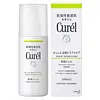What's inside
What's inside
 Key Ingredients
Key Ingredients

No key ingredients
 Benefits
Benefits

 Concerns
Concerns

 Ingredients Side-by-side
Ingredients Side-by-side

Water
Skin ConditioningGlycerin
HumectantNiacinamide
SmoothingPropanediol
SolventDimethicone
EmollientIsononyl Isononanoate
EmollientCeramide NP
Skin ConditioningCeramide AP
Skin ConditioningCeramide EOP
Skin ConditioningCarbomer
Emulsion StabilisingDimethicone Crosspolymer
Emulsion StabilisingCetearyl Alcohol
EmollientBehentrimonium Methosulfate
Triethyl Citrate
MaskingSilica
AbrasiveSodium Hydroxide
BufferingSodium Hyaluronate
HumectantSodium Lauroyl Lactylate
EmulsifyingCholesterol
EmollientPhenoxyethanol
PreservativeTocopherol
AntioxidantChlorphenesin
AntimicrobialCaprylyl Glycol
EmollientTrisodium Ethylenediamine Disuccinate
Biosaccharide Gum-1
HumectantXanthan Gum
EmulsifyingPhytosphingosine
Skin ConditioningBenzoic Acid
MaskingWater, Glycerin, Niacinamide, Propanediol, Dimethicone, Isononyl Isononanoate, Ceramide NP, Ceramide AP, Ceramide EOP, Carbomer, Dimethicone Crosspolymer, Cetearyl Alcohol, Behentrimonium Methosulfate, Triethyl Citrate, Silica, Sodium Hydroxide, Sodium Hyaluronate, Sodium Lauroyl Lactylate, Cholesterol, Phenoxyethanol, Tocopherol, Chlorphenesin, Caprylyl Glycol, Trisodium Ethylenediamine Disuccinate, Biosaccharide Gum-1, Xanthan Gum, Phytosphingosine, Benzoic Acid
Water
Skin ConditioningGlycerin
HumectantButylene Glycol
HumectantDimethicone
EmollientCetyl-Pg Hydroxyethyl Palmitamide
Skin ConditioningSodium Methyl Stearoyl Taurate
CleansingAllantoin
Skin ConditioningAcrylates/C10-30 Alkyl Acrylate Crosspolymer
Emulsion StabilisingHydroxypropyl Methylcellulose
Emulsion StabilisingHydroxyundecanoic Acid
Skin ConditioningArginine
MaskingZinc Oxide
Cosmetic ColorantEucalyptus Globulus Leaf Extract
PerfumingBis-Methoxypropylamido Isodocosane
EmollientMethylparaben
PreservativeWater, Glycerin, Butylene Glycol, Dimethicone, Cetyl-Pg Hydroxyethyl Palmitamide, Sodium Methyl Stearoyl Taurate, Allantoin, Acrylates/C10-30 Alkyl Acrylate Crosspolymer, Hydroxypropyl Methylcellulose, Hydroxyundecanoic Acid, Arginine, Zinc Oxide, Eucalyptus Globulus Leaf Extract, Bis-Methoxypropylamido Isodocosane, Methylparaben
 Reviews
Reviews

Ingredients Explained
These ingredients are found in both products.
Ingredients higher up in an ingredient list are typically present in a larger amount.
Dimethicone is a type of synthetic silicone created from natural materials such as quartz.
What it does:
Dimethicone comes in different viscosities:
Depending on the viscosity, dimethicone has different properties.
Ingredients lists don't always show which type is used, so we recommend reaching out to the brand if you have questions about the viscosity.
This ingredient is unlikely to cause irritation because it does not get absorbed into skin. However, people with silicone allergies should be careful about using this ingredient.
Note: Dimethicone may contribute to pilling. This is because it is not oil or water soluble, so pilling may occur when layered with products. When mixed with heavy oils in a formula, the outcome is also quite greasy.
Learn more about DimethiconeGlycerin is already naturally found in your skin. It helps moisturize and protect your skin.
A study from 2016 found glycerin to be more effective as a humectant than AHAs and hyaluronic acid.
As a humectant, it helps the skin stay hydrated by pulling moisture to your skin. The low molecular weight of glycerin allows it to pull moisture into the deeper layers of your skin.
Hydrated skin improves your skin barrier; Your skin barrier helps protect against irritants and bacteria.
Glycerin has also been found to have antimicrobial and antiviral properties. Due to these properties, glycerin is often used in wound and burn treatments.
In cosmetics, glycerin is usually derived from plants such as soybean or palm. However, it can also be sourced from animals, such as tallow or animal fat.
This ingredient is organic, colorless, odorless, and non-toxic.
Glycerin is the name for this ingredient in American English. British English uses Glycerol/Glycerine.
Learn more about GlycerinWater. It's the most common cosmetic ingredient of all. You'll usually see it at the top of ingredient lists, meaning that it makes up the largest part of the product.
So why is it so popular? Water most often acts as a solvent - this means that it helps dissolve other ingredients into the formulation.
You'll also recognize water as that liquid we all need to stay alive. If you see this, drink a glass of water. Stay hydrated!
Learn more about Water